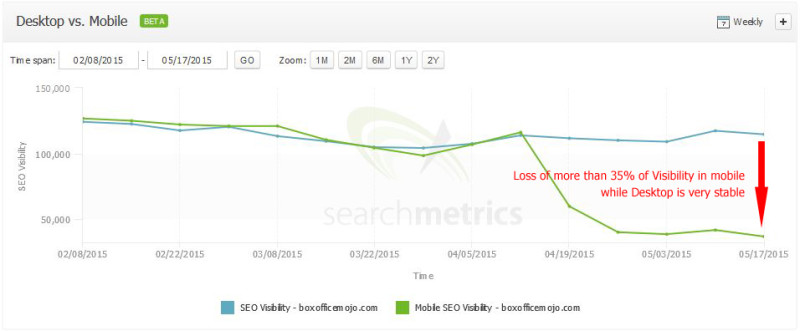Around this time last year, those involved in developing and managing websites were waiting for what had been termed “Mobilegeddon”: Google’s then upcoming algorithmic change that was going to totally shake up how we search online.
Twelve months on we are left with one question: what actually happened?
Mobilegeddon: a quick review
- Mobilegeddon was a Google algorithm update that took place on 21 April 2015.
- The update was aimed at making the web more mobile-friendly in response to increasing traffic from mobile devices.
- The update essentially did an automatic review of each website and, based on factors like font size, tap targets, button links being close together, and content readability, determined if it was mobile friendly or not.
- If your site was mobile-friendly, then you got a boost in search engine results; if your site was not mobile friendly, you were penalized and pushed down the rankings.
Importantly, unlike previous updates, if you were deemed to not be mobile-friendly and then made changes, you didn’t have to wait for Google to notice – your site would spring back on its own.
The reason that there was such an awareness around Mobilegeddon was that unlike previous updates, this one was set to impact a much larger number of websites, including
major websites of Fortune 500 companies.
What Google wanted to happen
Google’s rational for the change was, users were increasingly browsing from mobile devices and they wanted to be able to provide them the best experience. They reasoned that by linking a positive mobile experience to a company’s wallet, they could encourage and speed up the transition to a mobile-friendly web. Google balanced this change in the algorithm by having its impact limited to
mobile traffic. If you were searching for something on a mobile device, they wanted to only display results that would be mobile friendly. If you were doing your search on a desktop, the results wouldn’t be impacted by which was mobile-enabled.
What everyone said would happen
Predictions ranged, but many thought that major websites, including 40% of Fortune 500 companies, were going to be seriously impacted which would lead to a mad scramble to get mobile websites up and running as quickly as possible to regain market share.
For example,
TechCrunch reported on a list of major websites that were not mobile friendly. Many consumer-facing websites like Wal-Mart, GM, Ford, Apple, HP, and Costco were fine. However, non-consumer companies like Fannie Mae, UnitedHealth Group, Valero Energy and McKesson fared poorly. The hope was that these sites (and others) would see a financial impact from their poor ranking that they would immediately improve their mobile experiences.
What actually happened
As you can see from the report provided by Search Engine Land, there was a significant reduction in mobile traffic to a non-mobile-friendly website.
[caption id="attachment_4651" align="aligncenter" width="800"]

via
Search Engine Land[/caption]
However, in terms of the real impact on traffic and rankings, the average change was much smaller than everyone predicted. Many websites were already mobile friendly, and even if they weren’t, they either weren’t acquiring much of their traffic from mobile devices anyways, or the change just didn’t have a significant impact.
Another factor that affected the overall impact of this update is that the general mix of traffic to most sites meant that there weren’t that many obvious profound ‘winners’ and ‘losers’. Generally speaking, websites will get a mix of traffic from various devices, so even if their mobile traffic was punished, there would be enough other traffic to offset it.
The final tally was captured by BrightEdge, who tracked 20,000 URLs through the two weeks of mobilegeddon’s rollout. At the end of it,
17% of these URLs were no longer on the front page of search results. So yes, there was some change, but for the most part it was more minor than
Google’s Panda update, and easier to fix.
Winners and losers
So, who’s actually better off?
Search metrics compiled a list of winners and losers based on mobile SEO visibility. Major winners included companies like Upworthy, bandcamp, GQ and tvttropes.com with a 420% gain in visibility.
The losers are, for the most part, minor websites like fool.com, youngmoney.com, and Sidereel, but also some serious heavyweights like Reddit (visibility down 27%) nbcsports.com (visibility down 28%) and usps.gov (visibility down 20%).
Conclusion
All in all, Mobilegeddon was an important step to making mobile-friendly part and parcel of web. The buildup and media buzz around it was probably more useful than the update itself in getting companies to make their websites mobile friendly, but we believe had a lasting impact on how people approach their online presence and it set a precedent that it’s the mobile way or the highway when it comes to Google search results.
